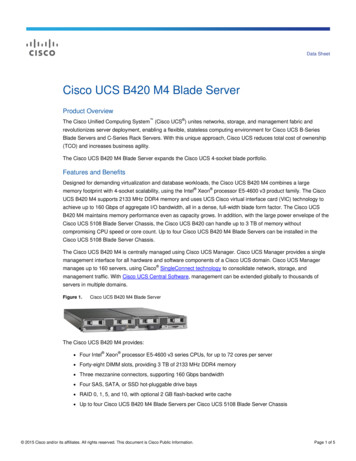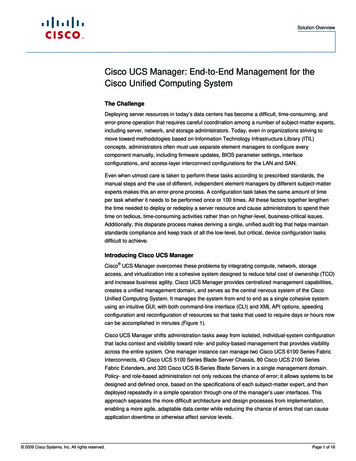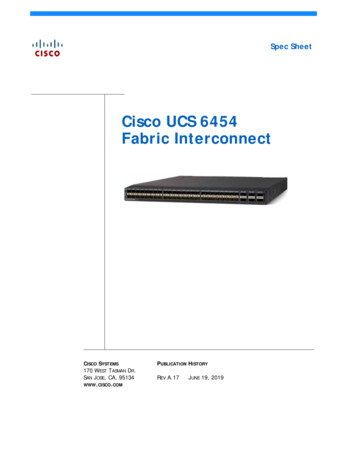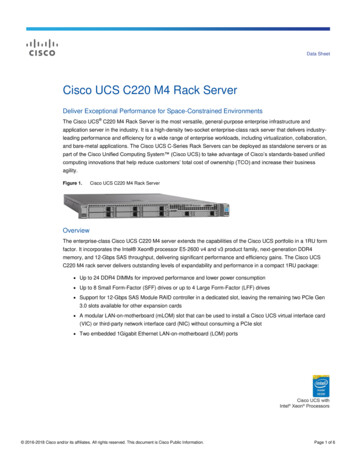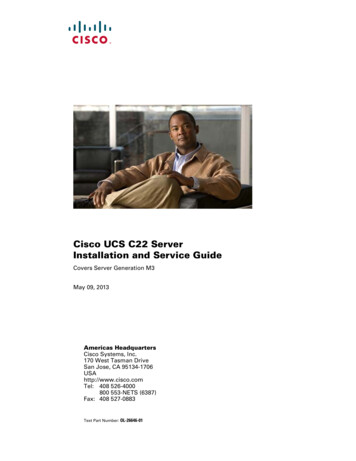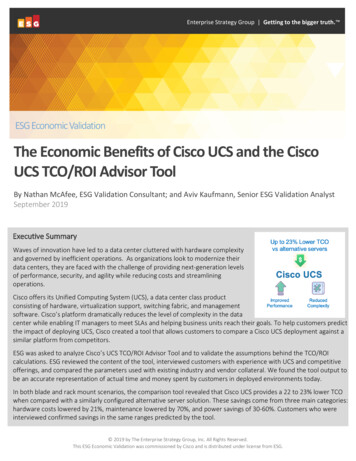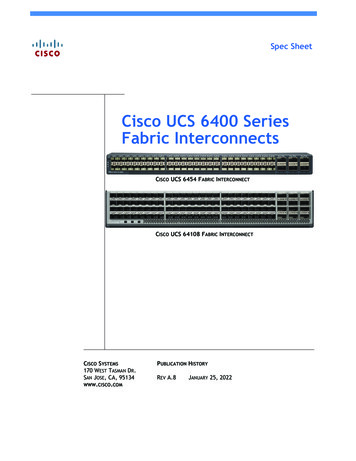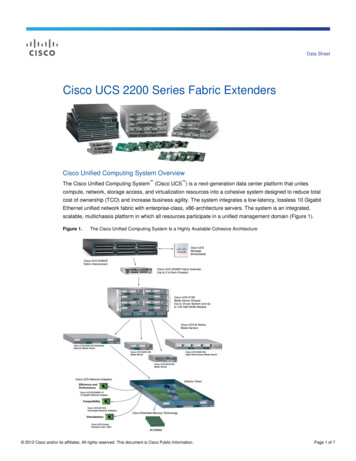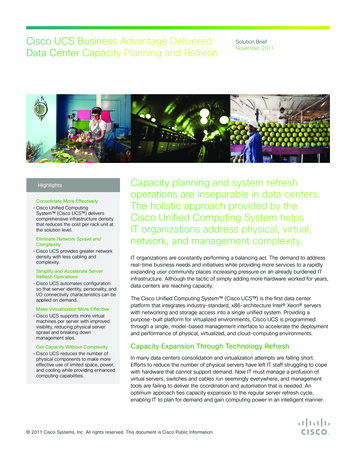
Transcription
Cisco UCS Business Advantage Delivered:Data Center Capacity Planning and RefreshHighlightsConsolidate More Effectively Cisco Unified ComputingSystem (Cisco UCS ) deliverscomprehensive infrastructure densitythat reduces the cost per rack unit atthe solution level.Eliminate Network Sprawl andComplexity Cisco UCS provides greater networkdensity with less cabling andcomplexity.Simplify and Accelerate ServerRefresh Operations Cisco UCS automates configurationso that server identity, personality, andI/O connectivity characteristics can beapplied on demand.Make Virtualization More Effective Cisco UCS supports more virtualmachines per server with improvedvisibility, reducing physical serversprawl and breaking downmanagement silos.Get Capacity Without Complexity Cisco UCS reduces the number ofphysical components to make moreeffective use of limited space, power,and cooling while providing enhancedcomputing capabilities.Solution BriefNovember 2011Capacity planning and system refreshoperations are inseparable in data centers.The holistic approach provided by theCisco Unified Computing System helpsIT organizations address physical, virtual,network, and management complexity.IT organizations are constantly performing a balancing act. The demand to addressreal-time business needs and initiatives while providing more services to a rapidlyexpanding user community places increasing pressure on an already burdened ITinfrastructure. Although the tactic of simply adding more hardware worked for years,data centers are reaching capacity.The Cisco Unified Computing System (Cisco UCS ) is the first data centerplatform that integrates industry-standard, x86-architecture Intel Xeon serverswith networking and storage access into a single unified system. Providing apurpose-built platform for virtualized environments, Cisco UCS is programmedthrough a single, model-based management interface to accelerate the deploymentand performance of physical, virtualized, and cloud-computing environments.Capacity Expansion Through Technology RefreshIn many data centers consolidation and virtualization attempts are falling short.Efforts to reduce the number of physical servers have left IT staff struggling to copewith hardware that cannot support demand. Now IT must manage a profusion ofvirtual servers, switches and cables run seemingly everywhere, and managementtools are failing to deliver the coordination and automation that is needed. Anoptimum approach ties capacity expansion to the regular server refresh cycle,enabling IT to plan for demand and gain computing power in an intelligent manner. 2011 Cisco Systems, Inc. All rights reserved. This document is Cisco Public Information.
Cisco UCS Business Advantage Delivered:Data Center Capacity Planning and RefreshDo More with LessIT organizations that integrate CiscoUCS into capacity planning and serverrefresh cycles really can do more withless. IT staff can perform more taskswith less effort, manage infrastructurebetter with fewer tools, and increasecapacity in a smaller footprint.With Cisco UCS, servers, networking,storage, and intelligent managementwork together in a self-aware and selfintegrating system. This design deliversgreater computing density, virtualization,and network simplicity in a smallerfootprint that reduces operating costs.For example, with the combination ofpowerful Intel Xeon processors, someof the largest memory capacitiesavailable in blade servers, and upto 160 Gbps of I/O bandwidth perserver, Cisco UCS delivers enhancedperformance and makes optimal use oflimited space.In traditional systems, virtualinfrastructure is just as inflexible andcomplex as the physical infrastructureit replaced. Cisco UCS providesthe capability to simplify virtualinfrastructure and deploy systemswith ease. Physical and virtual serverscan be configured and repurposedat a moment’s notice to supportdynamically changing workloadsand growing capacity demands. Inaddition, built-in management functionsprovide exceptional visibility into andcontrol over the entire infrastructureto streamline and coordinateadministrative effort and eliminatecommon errors that delay deploymentand disrupt operation.More Effective Data CenterConsolidationIT organizations are continuallyexpanding the capacity of their existinginfrastructure to support growingdemand. Over time, the constant influxof servers, switches, storage, andcabling results in a sprawling, complexinfrastructure that places excessivedemand on power and coolingresources and is costly and difficult tomanage. As a result, many data centersare simply running out of space andpower. Greater infrastructure density isneeded if data centers are to recapturevaluable floor space and have room togrow.Increase Data Center DensityMost vendors focus on serverdensity and virtualization withoutconsidering how they affect thedata center as a whole. Cisco UCSdelivers comprehensive infrastructuredensity—servers, switches, cabling, andmanagement—that reduces the costper rack unit at the solution level andincreases operation efficiency at thedata center level.Transcending the boundaries oftraditional blade chassis and racks,Cisco UCS creates a physicallydistributed, centrally managed systemthat supports blade and rack-mountservers to deliver scalability andperformance. A unified fabric supportedby a single, distributed virtual switchinterconnects all server resources.Servers and virtual machines areinterconnected equally and consistently, 2011 Cisco Systems, Inc. All rights reserved. This document is Cisco Public Information. Over 90 Percent SmallerFootprint and Less Power Usewith a US 600,000 SavingsFacing further cuts to an already tightbudget, the University InformationSystems (UIS) group at the Universityof Colorado was forced to reevaluateits existing infrastructure. Keith Lard,director of enterprise cloud servicesat UIS says, “We had scaled our datacenter in a horizontal fashion, andwe had reached the limit of what wecould power and cool in our existingdata center.”UIS deployed a number of CiscoUCS B-Series Blade Servers, CiscoNexus 1000V Series Switches, andCisco Nexus 1010 Virtual ServicesAppliances for optimal performanceand capacity and dense virtualization.Ultimately, UIS consolidated 300servers in 24 racks into 10 CiscoUCS servers in 2 racks, reducingthe university’s data center footprintfrom approximately 5000 square feetto 200 square feet, and reducing itspower and network cabling by 1000cables.By shrinking the physical capacityof its data center by 96 percent,and consequently reducing powerconsumption by 90 percent, theUIS team saves approximatelyUS 600,000 per al/ns340/ns517/ns224/U of Colorado casestudy final.pdfeliminating multiple layers of switching.This radically simplified architecturepacks more computing power intoless space while allowing IT to choosefrom a portfolio of servers to delivermassive computing density andPage 2 of 6
Cisco UCS Business Advantage Delivered:Data Center Capacity Planning and Refreshscalability. Workloads can be sized tomeet application needs and moved tolarger systems as demand grows. TheCisco UCS approach yields greatermanagement and space efficienciesfor consolidation, and integratesand simplifies refresh planningand implementation for increasedcomputing capacity.Blade Scalability at Up to Half the Cost and ComplexityServer costs are significant, but so is the cost of infrastructure to support each server.Cisco Fabric Extender Technology architecture (FEX Technology) dramatically reducesthe number of interfaces, cables, and switches needed to support Cisco UCS bladeservers. As a result, the average per-server infrastructure cost is US 2343 for CiscoUCS compared to US 3761 for an HP system—a 38 percent savings.* Starting with thesecond chassis, adding an additional HP chassis can increase infrastructure costs byUS 39,000 to US 45,000 more than the efficient Cisco UCS design (Figure 1). 300,000 250,000Chassis Plus I/0 CostsWith Cisco UCS, scaling is moregraceful and cost effective than withtraditional blade server architectures.The addition of the next blade serverchassis does not require installationof tens of thousands of dollars ofadditional networking infrastructure.Each Cisco UCS increment of scalebrings enhanced manageability andcontrol without adding layers ofmanagement tools. 200,000 137,424 86,022 150,000Savingsfor 17th Blade 100,000 39,739 50,000 016172432404856647280Number of Chassis SlotsOvercome the Challenges of SiloedArchitecturesThe architectural silos that result froman ad hoc approach to capacity scalingcreate additional challenges. Isolationfrom other areas of the infrastructurecreates barriers to resource sharingand requires additional dedicatedservers standing by to take overwork in the event of a failure. CiscoUCS eliminates architectural silosthrough on-demand provisioning. Anycomputing resource potentially can beused for any application at any time.The infrastructure is “wire once” withall configuration managed throughCisco UCS Manager, eliminating thephysical barriers that used to preventapplications from sharing resources.Cisco UCS 5108HP c7000Infrastructure Savingswith Cisco UCS*Based on the Cisco UCS manufacturer’s suggested retail price (MSRP) and HP retail price on November 2, 2011Figure 1. Comparison of Cisco UCS and HP Infrastructure Costs (in US Dollars)The intelligent infrastructure providedby Cisco UCS enables the entireconfiguration to be programmedthrough the intuitive Cisco UCSManager GUI and open standard XMLAPI. While other vendors supportthe automatic configuration of a fewparameters, Cisco UCS Managerincludes nearly 100 server identityparameters, eliminating the needfor manual tasks or the creationof scripts or the use of tools andagents that further complicate the ITenvironment. With Cisco UCS Manager, 2011 Cisco Systems, Inc. All rights reserved. This document is Cisco Public Information. IT organizations can plan capacity on aholistic, data center wide basis, sharinginfrastructure across applications andharnessing it to best meet businesspriorities and service-level agreements(SLAs).Eliminating Networkand Cable Sprawl andComplexityUsing traditional implementations, theconnection of servers and storagesystems to growing numbers of userPage 3 of 6
Cisco UCS Business Advantage Delivered:Data Center Capacity Planning and Refreshapplications and services requiresextensive networking infrastructure.The resulting dramatically increasedconnectivity uses massive numbersof cables, creating significantmanagement challenges. Administratorsfind it difficult to locate ports for newservers, to map and zone connectivity,and to track and locate sourcesof failures. In addition, this cableproliferation and sprawl requires vastnumbers of switch ports and switches,which consume power and increasemanagement complexity.Simplified Network InfrastructureAddressing the increasing need forbetter design and control, Cisco UCSprovides greater network density withless cabling and complexity. Cisco’sunified fabric integrates Cisco UCSservers with a single high-bandwidth,low-latency network that supportsall system I/O. This fabric carries IP,storage, and management traffic overredundant 10 Gigabit Ethernet andFibre Channel over Ethernet (FCoE)networks. This approach simplifies thearchitecture and reduces the numberof I/O interfaces, cables, and accesslayer switch ports that are required fortraditional platforms. This unification canreduce network complexity by up to afactor of three, and the system’s wireonce network infrastructure increasesagility and accelerates deployment withzero-touch configuration.All I/O traffic meets at a single specificand redundant point at which it isefficiently and consistently managed,increasing network security, simplifyingmanagement, and reducing errors.This approach eliminates blade-serverand hypervisor-resident switching,condensing three network layersinto one and reducing capital andoperating costs. With the capability tointerconnect physical servers and virtualmachines as functional equivalents,the architecture delivers outstandingvisibility and control that lets virtualnetworks be managed with the samelevel of control as physical networks.Simplifying and AcceleratingServer Refresh OperationsThe ad hoc approach to expansionused in many data centers makes itdifficult to refresh and consolidate theenvironment. Cumbersome processesthat are tied to a complicated physicaland virtual infrastructure hamper IT’sability to install and configure newsystems and to rehost virtual serversand applications. Administrators mustperform tedious, repetitive, and timeconsuming tasks that are often thesource of errors or result in inconsistentconfigurations or application ofcorporate policies and security. Thesedelays and inconsistencies affectapplication and service redeploymentand keep the IT organization fromsupporting real-time business needsand priorities.Automated Configuration for FastDeploymentCisco UCS simplifies and acceleratesserver refresh operations throughautomated configuration. The intelligentinfrastructure abstracts server identity,personality, and I/O connectivityfrom the hardware, enabling thesecharacteristics to be applied ondemand. Every aspect of a server’sconfiguration, from firmware revisionsand BIOS settings to network profiles, 2011 Cisco Systems, Inc. All rights reserved. This document is Cisco Public Information. can be assigned through the system’sopen, documented, standards-basedXML API or Cisco UCS Manager GUI.As a result, server configurations canbe replicated easily. A new server canappear to the software stack just likethe old server, making server refreshoperations as simple as applying aCisco service profile and rebooting tolaunch the new system.Service Profiles Support PrestagingCisco service profile templatesestablish policy-based configurationfor server, network, and storageresources and can be used to logicallypreconfigure these resources evenbefore they are deployed in the datacenter. By preparing service profiles inadvance, administrators can prestageIP addresses and storage world-widenames (WWNs) and attach mappingsto components. In addition, CiscoUCS blade server slots can be set toautomatically configure blade serversupon insertion with network andstorage settings that are in compliancewith the policies established byappropriate data center administrators.Configuration also can be performed asa manual process as needed, with fullserver identity parameter control andintegration with network and storageresources.Making Virtualization MoreEffectiveAs data centers reach the limits oftheir physical capacity, virtualizationstrategies to consolidate workloadsonto fewer resources can be importantaids. Yet the virtualization effortsdeployed by many data centers haveresulted in new challenges. The usePage 4 of 6
Cisco UCS Business Advantage Delivered:Data Center Capacity Planning and Refreshof blade server chassis-residentnetworks and hypervisor-residentsoftware switches creates a complexset of switching layers that makesmanaging, debugging, and securingvirtual networks difficult. Server sprawlcontinues unabated, with a proliferationof physical servers added to theenvironment to support a vast arrayof virtual machines, delivering everincreasing numbers of applicationsand services. With a patchworkof technologies in place, physicaland virtual systems are deployed,connected, and managed in manydifferent ways, further complicatinginfrastructure administration andmanagement.More Virtualization at Less CostCisco UCS enables IT organizations tomeet ever-increasing guest operatingsystem memory footprint demands onfewer physical servers. The system’shigh density, high-performance design,including Cisco Extended MemoryTechnology, increases consolidationratios for 2-socket servers, saving thecapital, operating, physical space, andlicensing costs of running virtualizationsoftware on larger, 4-socket servers.With support for up to 1 terabyte(TB) of high-speed memory in a2-socket server, organizations canhost applications using less-expensiveservers without sacrificing performance.As a result, IT organizations can putmore virtual machines on each server,reducing physical server sprawl andbreaking down management silos.Greater Visibility and ControlIT organizations need to simplifyphysical infrastructure to break downsilos and make the data center moreeffective. They also need to improvetheir virtual infrastructure so that it canbe managed just as simply and easily Servers Fabric Interconnects Fabric Extendersas it scales. Traditional virtualizedenvironments require the use ofsoftware-based switches that reside inthe hypervisor. The insertion of a newswitch can cause a loss of visibility fromthe physical network interface to virtualmachines. The result is a network ofvirtual machines with connection pointsthat cannot be seen. If connectionscannot be seen, they cannot bemanaged or secured.Cisco UCS uses virtualization-optimizednetworking that makes managingvirtual machine networks equivalentto managing physical networks.Cisco FEX Technology architectureextends the visibility of network andstorage access all the way to individualvirtual machines, without hypervisorintervention. These connectionsterminate in the fabric interconnects asvirtual ports that are managed exactlythe same way as physical ports. VirtualCisco UCSManager(Embedded)Distributed Virtual Blade ChassisFigure 2. Cisco UCS Combines Blade and Rack Servers, Networking, and Storage Resources in a Distributed, Virtual Blade Chassis with aSingle, Redundant Point of Connectivity and Management 2011 Cisco Systems, Inc. All rights reserved. This document is Cisco Public Information. Page 5 of 6
Cisco UCS Business Advantage Delivered:Data Center Capacity Planning and Refreshnetwork interface cards (vNICs) areattached to virtual machines, and theirnetwork profiles remain constant andattached, even when virtual machinesare moved from one physical server toa different server, enhancing mobilityand security. Workloads can bemigrated between physical devices,optimizing performance and maintainingsecurity protocols and policies, withoutrequiring intervention by the networkteam to reset quality of service (QoS)and security for each migrated virtualmachine.The Cisco UCS design results ina distributed, virtual blade chassisthat combines the performance andmanagement of physical networkswith the scalability of virtual networks.Administrators can use familiarmanagement models on virtualmachines and take advantage of builtin automation and intelligence to gainoutstanding visibility into, and controlover, virtualized environments. Forexample, bandwidth can be flexibly anddynamically managed with a QoS policyto help guarantee bandwidth for priorityworkloads running in virtual machines,while also helping ensure that overallbandwidth is used efficiently and notwasted (Figure 2).Americas HeadquartersCisco Systems, Inc.San Jose, CAMore Capacity and ReducedComplexityData center infrastructure managementhas become a complicated challenge.The proliferation of management pointsand the physical devices to which theyare connected has resulted in a newkind of sprawl that must be contained.Typically, administrators have to usea variety of element managers tointeract with dozens of managementtouch points that are distributedacross multiple servers, blade chassis,racks, networking, and storageresources. Unfortunately, most vendorsattempt to solve this managementchallenge by introducing additionallayers of management tools that arepatched together into an accidentalarchitecture that creates more work foradministrators.Less Complex and Easier to ManageThe unified infrastructure andarchitecture-by-design approach ofCisco UCS delivers the scalabilityneeded to perform capacity planningand refresh activities without thecomplexity of traditional systems.The dramatic reduction in the numberof physical components results in asystem that makes effective use oflimited space, power, and cooling bydeploying less infrastructure to performthe same, or even more, work.Asia Pacific HeadquartersCisco Systems (USA) Pte. Ltd.SingaporeThe system’s unified fabric results infewer NICs, host bus adapters (HBAs),cables, and upstream switch ports,and eliminates the need for a parallelFibre Channel end-to-end network.Traditional blade server chassis residentswitches are replaced by a low-cost,low-power, zero-management fabricextender that enables the entire systemto scale across multiple blade chassisand rack servers without addingmanagement points. All hardware andsoftware components are managedthrough the unified, embedded CiscoUCS Manager to improve operationefficiency with seamless scaling.ConclusionDeployment of Cisco UCS systemsenables data centers to reap thebenefits of a simplified infrastructure.By consolidating from a large-footprintrack or complex and network-intensiveblade environment to Cisco UCS, ITorganizations can reduce the footprintand complexity of the entire datacenter.Server refresh and consolidationoperations become easy, scalable, andrepeatable exercises that optimize datacenter investments.Learn MoreTo learn more about Cisco UCS, visithttp://www.cisco.com/go/ucsor contact your local accountrepresentative.Europe HeadquartersCisco Systems International BV Amsterdam,The NetherlandsCisco has more than 200 offices worldwide. Addresses, phone numbers, and fax numbers are listed on the Cisco Website at www.cisco.com/go/offices.Cisco and the Cisco logo are trademarks or registered trademarks of Cisco and/or its affiliates in the U.S. and other countries. To view a list of Cisco trademarks, go to thisURL: www.cisco.com/go/trademarks. Third party trademarks mentioned are the property of their respective owners. The use of the word partner does not imply a partnershiprelationship between Cisco and any other company. (1110R) LE-33701-00 11/11
Cisco UCS 5108 HP c7000 Infrastructure Savings with Cisco UCS 86,022 137,424 Savings for 17th Blade 39,739 *Based on the Cisco UCS manufacturer's suggested retail price (MSRP) and HP retail price on November 2, 2011 Figure 1. Comparison of Cisco UCS and HP Infrastructure Costs (in US Dollars)
